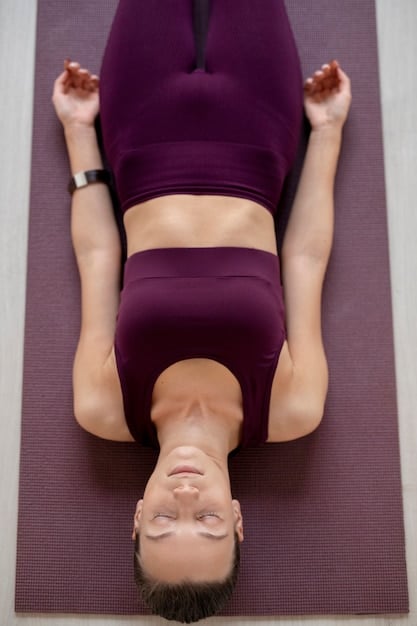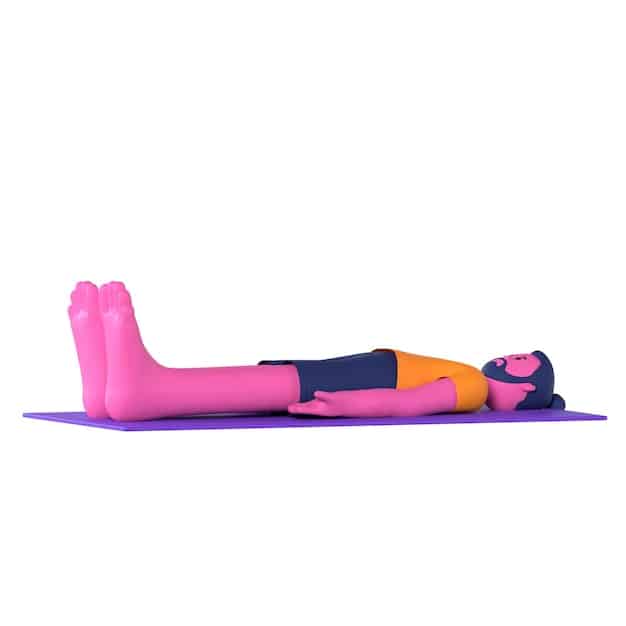Yoga for Sleep: Your 15-Minute Bedtime Routine for Better Sleep

Yoga for sleep offers a natural and effective way to unwind and prepare your body for a restful night. This step-by-step guide provides a simple 15-minute bedtime yoga routine designed to reduce stress, calm the mind, and improve overall sleep quality.
Do you toss and turn at night, struggling to quiet your mind? Yoga for sleep: A Step-by-Step Guide to a 15-Minute Bedtime Routine for Improved Sleep Quality can provide a gentle and effective solution. This guide will walk you through a simple yoga sequence designed to ease you into a peaceful slumber.
Understanding the Connection Between Yoga and Sleep
Many people struggle with sleep issues, whether it’s difficulty falling asleep, staying asleep, or waking up feeling refreshed. Yoga, with its emphasis on mindful movement and breathwork, can be a powerful tool in addressing these concerns by promoting relaxation and reducing stress.
How Yoga Calms the Nervous System
Yoga helps to regulate the nervous system by activating the parasympathetic nervous system, often referred to as the “rest and digest” response. This counteracts the effects of the sympathetic nervous system, which is responsible for the “fight or flight” response triggered by stress.
The Role of Breathwork in Sleep
Specific breathing techniques, known as pranayama, are integral to yoga and can significantly impact sleep. Deep, controlled breathing helps to slow down the heart rate, lower blood pressure, and quiet the mind, creating a favorable environment for sleep.
- Reduces Cortisol Levels: Yoga and breathwork can lower cortisol, the stress hormone, which is often elevated in individuals with sleep problems.
- Increases Melatonin Production: Certain yoga poses and breathing exercises can stimulate the production of melatonin, the hormone that regulates sleep-wake cycles.
- Promotes Mental Clarity: By focusing on the present moment, yoga helps to clear the mind of racing thoughts and worries that can interfere with sleep.
In essence, the combination of physical postures (asanas) and mindful breathing makes yoga a holistic practice for promoting relaxation, reducing stress, and improving sleep quality. By incorporating yoga into your bedtime routine, you can naturally enhance your ability to fall asleep and enjoy more restorative rest.

Preparing Your Space and Mind for Bedtime Yoga
Creating a calming and conducive environment is essential for maximizing the benefits of your bedtime yoga routine. This involves setting the stage both physically and mentally to ensure you’re relaxed and ready to unwind.
Creating a Sleep-Conducive Environment
Transform your bedroom into a sanctuary for sleep by minimizing distractions and creating a sense of tranquility. This includes adjusting the lighting, temperature, and sound levels to promote relaxation.
Setting Intentions and Letting Go of the Day’s Stress
Before you begin your yoga practice, take a few moments to set an intention for your sleep. This could involve focusing on letting go of the day’s worries, cultivating gratitude, or simply setting the intention to relax fully.
- Dim the Lights: Use soft, warm lighting to signal to your brain that it’s time to wind down.
- Maintain a Cool Temperature: Keep your bedroom at a comfortable temperature, ideally between 60 and 67 degrees Fahrenheit, to promote optimal sleep.
- Minimize Noise: Use earplugs or a white noise machine to block out distracting sounds.
- Set the Mood with Aromatherapy: Consider using calming essential oils like lavender or chamomile to enhance relaxation.
By preparing your space and mind for bedtime yoga, you create a ritual that signals to your body and mind that it’s time to rest and rejuvenate. This intentional approach can significantly enhance the effectiveness of your yoga practice and improve your sleep quality.
A Step-by-Step 15-Minute Bedtime Yoga Routine
This 15-minute yoga routine is designed to be gentle, restorative, and accessible to all levels. Each pose is carefully selected to promote relaxation, reduce muscle tension, and calm the mind, preparing you for a restful night’s sleep.
Child’s Pose (Balasana) – 2 Minutes
Begin on your hands and knees, then sit back on your heels. Gently fold forward, resting your forehead on the mat. Extend your arms forward or keep them alongside your body, palms facing up. Focus on deep, even breaths, allowing your body to release tension.
Reclined Butterfly Pose (Supta Baddha Konasana) – 3 Minutes
Lie on your back and bring the soles of your feet together, letting your knees fall open to the sides. Place your hands on your belly or alongside your body, palms facing up. Close your eyes and focus on relaxing your hips and inner thighs.
Legs-Up-the-Wall Pose (Viparita Karani) – 5 Minutes
Sit with one hip close to a wall, then gently swing your legs up the wall as you lie on your back. Keep your hips as close to the wall as comfortable. Extend your arms alongside your body, palms facing up. Close your eyes and focus on relaxing your legs and feet.
Corpse Pose (Savasana) – 5 Minutes
Lie flat on your back with your arms alongside your body, palms facing up. Allow your feet to fall open to the sides. Close your eyes and completely relax your body and mind. Focus on your breath and let go of any thoughts or worries.

Modifications and Variations for Common Issues
Yoga should be accessible and comfortable for everyone, regardless of their physical abilities or limitations. This section provides modifications and variations for common issues, ensuring that you can tailor your bedtime yoga routine to suit your individual needs.
Addressing Lower Back Pain
If you experience lower back pain, modify poses to reduce strain on your spine. Use props like blankets or bolsters to support your body and maintain proper alignment.
Dealing with Neck Tension
For neck tension, support your head with a pillow or folded blanket during poses like Child’s Pose and Legs-Up-the-Wall Pose. Gentle neck stretches can also help to release tension.
- Child’s Pose with Knee Support: Place a rolled-up blanket between your thighs and calves to reduce pressure on your knees.
- Reclined Butterfly with Bolster: Place a bolster under your back for added support and comfort.
- Legs-Up-the-Wall with Bent Knees: If you have tight hamstrings, bend your knees slightly to reduce strain on your legs and lower back.
By making these adjustments and modifications, you can ensure that your bedtime yoga routine is safe, comfortable, and effective in promoting relaxation and improving sleep quality. Listen to your body and adjust as needed to create a practice that works best for you.
The Long-Term Benefits of Regular Bedtime Yoga
Consistency is key when it comes to reaping the long-term benefits of bedtime yoga. Regular practice can lead to significant improvements in sleep quality, stress management, and overall well-being.
Improved Sleep Quality and Duration
Over time, regular bedtime yoga can help to regulate your sleep-wake cycle, making it easier to fall asleep, stay asleep, and wake up feeling refreshed. This can lead to increased energy levels, improved mood, and enhanced cognitive function.
Reduced Stress and Anxiety Levels
Yoga is a powerful tool for managing stress and anxiety. Regular practice can help to calm the mind, reduce muscle tension, and promote a sense of inner peace, leading to a more relaxed and balanced state of mind.
- Enhanced Mindfulness: Yoga cultivates mindfulness, helping you to become more aware of your thoughts, feelings, and sensations in the present moment.
- Increased Self-Awareness: Regular practice can increase your self-awareness, allowing you to recognize and respond to stress triggers more effectively.
- Improved Emotional Regulation: Yoga can help you to regulate your emotions, reducing reactivity and promoting a sense of emotional stability.
Incorporating bedtime yoga into your daily routine can have a profound impact on your overall well-being. By making it a regular practice, you’ll experience the cumulative benefits of improved sleep, reduced stress, and enhanced mindfulness, leading to a happier, healthier, and more fulfilling life.
Troubleshooting Common Sleep Obstacles
Even with a consistent bedtime yoga routine, you may still encounter occasional sleep obstacles. This section provides practical tips and strategies for troubleshooting common issues and optimizing your sleep environment.
Dealing with a Racing Mind
If you find yourself struggling with racing thoughts before bed, try incorporating mindfulness techniques into your yoga practice. Focus on your breath, observe your thoughts without judgment, and gently redirect your attention back to the present moment.
Managing Physical Discomfort
Physical discomfort can often interfere with sleep. Address any underlying pain or discomfort with appropriate modifications to your yoga poses or by seeking professional medical advice.
- Create a Consistent Sleep Schedule: Go to bed and wake up at the same time each day, even on weekends, to regulate your body’s natural sleep-wake cycle.
- Limit Screen Time Before Bed: Avoid using electronic devices for at least an hour before bed, as the blue light emitted from screens can interfere with melatonin production.
- Avoid Caffeine and Alcohol Before Bed: Caffeine and alcohol can disrupt sleep patterns and make it more difficult to fall asleep and stay asleep.
By addressing these common sleep obstacles and implementing these troubleshooting tips, you can create a more favorable environment for sleep and maximize the benefits of your bedtime yoga routine. Remember to be patient with yourself and persistent in your efforts, and you’ll soon be enjoying more restful and restorative sleep.
| Key Point | Brief Description |
|---|---|
| 🧘♀️ Bedtime Yoga | Gentle yoga to calm the mind and body before sleep. |
| 😴 Sleep Quality | Improves sleep duration and reduces nighttime disturbances. |
| 🧘 Breathing | Deep breathing techniques enhance relaxation. |
| 🌙 Evening Routine | Consistency is key for long-term sleep benefits. |
Frequently Asked Questions
▼
The best time to practice yoga for sleep is in the evening, ideally 1-2 hours before bedtime. This allows your body and mind to fully unwind and prepare for sleep.
▼
For optimal results, aim to practice bedtime yoga every night. Consistency is key to regulating your sleep-wake cycle and reaping the long-term benefits of yoga.
▼
Yes, yoga can be a helpful tool in managing insomnia. Regular practice can reduce stress, calm the mind, and promote relaxation, making it easier to fall asleep and stay asleep.
▼
It’s perfectly fine to modify or skip poses that are uncomfortable or inaccessible to you. Listen to your body and adjust the routine to suit your individual needs and abilities.
▼
Bedtime yoga is generally safe for most people. However, if you have any underlying health conditions or injuries, consult with your doctor before starting a new yoga routine.
Conclusion
Incorporating yoga for sleep into your nightly routine offers a holistic approach to improving sleep quality. By following this step-by-step guide and making it a consistent practice, you can unlock a path to more restful nights and rejuvenated mornings.





